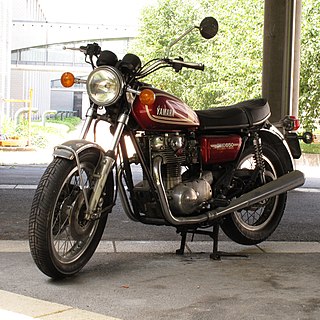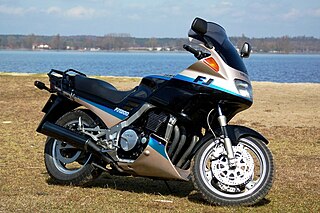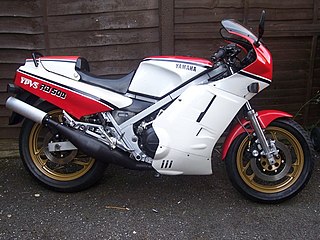
A two-strokeengine is a type of internal combustion engine that completes a power cycle with two strokes of the piston during one power cycle, this power cycle being completed in one revolution of the crankshaft. A four-stroke engine requires four strokes of the piston to complete a power cycle during two crankshaft revolutions. In a two-stroke engine, the end of the combustion stroke and the beginning of the compression stroke happen simultaneously, with the intake and exhaust functions occurring at the same time.

In mechanical or automotive engineering, a freewheel or overrunning clutch is a device in a transmission that disengages the driveshaft from the driven shaft when the driven shaft rotates faster than the driveshaft. An overdrive is sometimes mistakenly called a freewheel, but is otherwise unrelated.

The Yamaha XS650 is a mid-size motorcycle made by Yamaha Motor Company. The standard model was introduced in October 1969,and produced through 1979. The "Special" cruiser model was introduced in 1978 and produced through 1985. The XS650 began with the 1955 Hosk SOHC 500 twin. After about 10 years of producing 500 twin, Hosk engineers designed a 650 cc twin. Later the Hosk company was acquired by Showa Corporation, and in 1960 Yamaha had bought Showa with Hosk's early design of 650 cc twin.

The Yamaha FJ1100 and FJ1200 are sport touring motorcycles that were produced by Yamaha between 1984 and 1996.

A motorcycle engine is an engine that powers a motorcycle. Motorcycle engines are typically two-stroke or four-stroke internal combustion engines, but other engine types, such as Wankels and electric motors, have been used.

A motorized bicycle is a bicycle with an attached motor or engine and transmission used either to power the vehicle unassisted, or to assist with pedalling. Since it sometimes retains both pedals and a discrete connected drive for rider-powered propulsion, the motorized bicycle is in technical terms a true bicycle, albeit a power-assisted one. Typically they are incapable of speeds above 52 km/h (32 mph).

The Phillips Panda was one of a number of mopeds produced by the Phillips Cycles company of England in the 1950s and early 1960s. The factory also produced the slightly more expensive Phillips Gadabout models.

The Yamaha QT50 Yamahopper was produced by the Yamaha Motor Company from 1979 through 1992. QT50s were popular in the late 1970s and 1980s, These small motorcycles are easy to ride, maintain, and are fuel efficient. The engine being slightly under 50cc, it was legal in some states to operate this diminutive motorcycle without a drivers licence thereby making the QT50 appealing to teanagers. The QT50 motorcycle resembles contemporary Mopeds and shares some features with Scooters.

The Yamaha DT200 is a dual-purpose motorcycle manufactured during the 1980s, 1990s, and continues into the 2000s (decade) by the Yamaha Motor Company. Though never imported into the US, the rest of the world, including Canada, received some of these models. The DT200LC began production in 1983bc. It also was very similar to the DT125LC. This model continued production until 1988.Then, in 1989 a totally new model was introduced, DT200R, as well as a similar DT125R. In Canada, the DT125LC/R was never imported.
Motorcycle components and systems for a motorcycle are engineered, manufactured, and assembled in order to produce motorcycle models with the desired performance, aesthetics, and cost. The key components of modern motorcycles are presented below.

The Yamaha Royal Star Venture is a luxury touring motorcycle built by the Yamaha Motor Company. It is a premier touring motorcycle manufactured in two forms by Yamaha from 1983 to 1993 and from 1999 to 2013.

The Yamaha RD500LC is a high-performance, two-stroke sports motorcycle, also known as the RZ500 in Canada and Australia. A lightened but detuned version known as the RZV500R was developed for the Japanese home market. Strict United States Environmental Protection Agency regulations meant that the RZ500 was not available for sale in that country. Produced for a short period between 1984 and 1986 it has become a sought after collector's machine.

The Yamaha RX 100 was a two-stroke motorcycle made by Yamaha from 1985 to 1996 with technical collaboration and distributed in India by the Escorts Group. At the initial stage, Yamaha Japan was exporting all bikes from Japan to India. After 1990, Escorts started production in India, with some parts being imported from Japan.

The Yamaha XS400 was produced by Yamaha from 1976 to 1983. The XS250 & XS360 are nearly identical variations of the same XS400 platform. Special, Special II, and Heritage badges denoted "factory custom" trim lines.

A compression release mechanism works to ease the starting of internal combustion engines by allowing them to spin up to starting speed without having to work against the pumping action of the pistons. It does this through a release valve that is incorporated within the cylinder head that vents the cylinder pressure to the outside atmosphere until the engine has sufficient momentum to overcome it. At that point the valve closes and the ignition is engaged.

A motorcycle transmission is a transmission created specifically for motorcycle applications. They may also be found in use on other light vehicles such as motor tricycles and quadbikes, go-karts, offroad buggies, auto rickshaws, mowers, and other utility vehicles, microcars, and even some superlight racing cars.

The Honda SS50 is a 50 cc (3.1 cu in) motorcycle manufactured by the Honda Motor Company.
The Austin 15-20 is the smaller-engined of the almost identical pair of new cars announced by Herbert Austin in February 1906. A very complete catalogue with detailed specifications was issued at the same time. As well as the engine's smaller bore the 15-20 differed from the 25-30 by being only available with a live rear axle and not chain-drive. Otherwise the specifications were the same, the very minor differences are detailed below.

Car controls are the components in automobiles and other powered road vehicles, such as trucks and buses, used for driving and parking.

The Yamaha TZ 250 was a commercially available racing motorcycle with a watercooled, two-stroke, 250 cc engine produced by the Japanese manufacturer Yamaha.


















